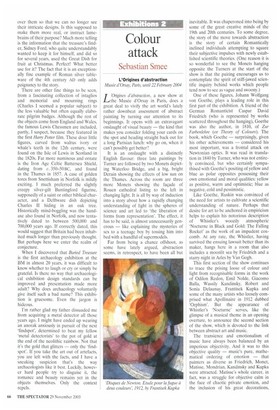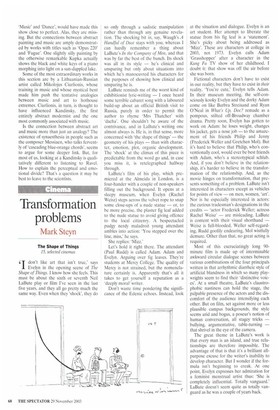Colour attack
Sebastian Smee
L'Orioines d'abstraction
Musae d'Orsay, Paris, until 22 Febntary 2004
I'Origines d'abstraction, a new show at i / the Musee d'Orsay in Paris, does a great deal to vivify the art world's lately rather downbeat assessment of abstract painting by turning our attention to its beginnings. It opens with an extravagant onslaught of visual beauty — the kind that makes you consider folding your cards on the spot and heading straight back out for a long Parisian lunch: why go on, when it can't possibly get better?
It is an onslaught with a distinctly English flavour: three late paintings by Turner are followed by two Monets depicting Waterloo Bridge, and a big, bright Derain showing the effects of low sun on the Thames. Across the room are three more Monets showing the facade of Rouen cathedral listing to the left in changing light. It is all by way of induction into a story about how a rapidly changing understanding of light in the spheres of science and art led to 'the liberation of forms from representation'. The effect, it has to be said, is almost unnecessarily generous — like explaining the mysteries of sex to a teenage boy by tossing him into bed with a handful of supermodels.
Far from being a chance offshoot, as some have lately argued, abstraction seems, in retrospect, to have been all but inevitable. It was chaperoned into being by some of the great creative minds of the 19th and 20th centuries. To some degree, the story of the move towards abstraction is the story of certain Romantically inclined individuals attempting to square their subjective impulses with newly established scientific theories. (One reason it is so wonderful to see the Monets hanging opposite the Turners at the start of the show is that the pairing encourages us to contemplate the spirit of stiff-jawed scientific inquiry behind works which people tend now to see as vague and swoony.) One of these figures, Johann Wolfgang von Goethe, plays a leading role in this first part of the exhibition. A friend of the German Romanticist Caspar David Friedrich (who is represented by works scattered throughout the hanging), Goethe was also the author, in 1810, of Zur Farbenlehre (or Theory of Colours). The book, which Goethe — surprisingly, given his other achievements — considered his most important, was a frontal attack on Newtonian optics. It was read in translation in 1840 by Turner, who was not entirely convinced, but who certainly sympathised with Goethe's positing of yellow and blue as polar opposites possessing their own emotional and moral qualities: yellow as positive, warm and optimistic; blue as negative, cold and pessimistic.
Like Goethe, Ruskin was convinced of the need for artists to cultivate a scientific understanding of nature. Perhaps that desire for art to be anchored in empiricism helps to explain his notorious description of Whistler's woozily atmospheric 'Nocturne in Black and Gold: The Falling Rocket' as the work of an impudent coxcomb. At any rate, the Whistler, having survived the ensuing lawsuit better than its maker, hangs here in a room that also includes a moonlit sea by Friedrich and a starry night in Aries by Van Gogh.
This first section of the show continues to trace the prising loose of colour and light from recognisable forms in the work of Odilon Redon, Emil Nolde, Giacomo Balla, Wassily Kandinsky, Robert and Sonia Delaunay, Frantisek Kupka and some of the many artists who loosely comprised what Apollinaire in 1912 dubbed 'Orphism'. But the appearance of Whistler's 'Nocturne' serves, like the glimpse of a musical theme in an opening overture, to announce the second section of the show, which is devoted to the link between abstract art and music.
The transience and emotionalism of music have always been balanced by an imperious objectivity. And it was to this objective quality — music's pure, mathematical ordering of emotion — that painters as diverse as Friedrich, Monet, Matisse, Mondrian, Kandinsky and Kupka were attracted. Matisse's whole career, in fact, was a struggle for objective calm in the face of chaotic private emotion, and the inclusion of his great decorations,
'Music' and 'Dance', would have made this show close to perfect. Alas, they are missing. But the connections between abstract painting and music are amply demonstrated by works with titles such as 'Opus 220' and 'Fugue'. One slightly silly painting by the otherwise remarkable Kupka actually shows the black and white keys of a piano morphing into light on a sun-dappled lake.
Some of the most extraordinary works in this section are by a Lithuanian-Russian artist called Mikolojus Ciurlionis, whose training in music and whose mystical bent made him push the tentative analogies between music and art to hothouse extremes. Ciurlionis. in turn, is thought to have influenced Kandinsky, the first entirely abstract modernist and the one most commonly associated with music.
Is the connection between abstract art and music more than just an analogy? The existence of synaesthesia in people such as the composer Messiaeri, who talks fervently of 'cascading blue-orange chords', seems to argue for some deeper link. But, for most of us, looking at a Kandinsky is qualitatively different to listening to Ravel. How to explain the perceptual and emotional divide? That's a question it may be best to leave to the scientists.



























































































 Previous page
Previous page